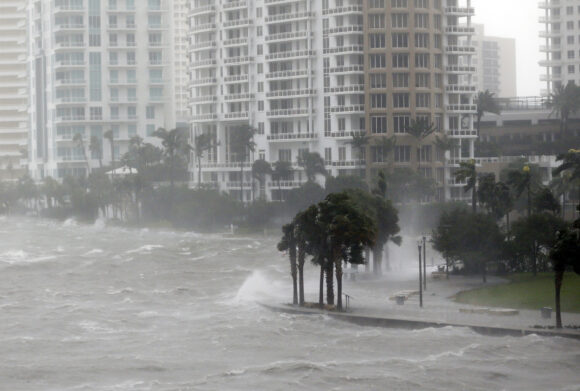TALLAHASSEE, Fla. (AP) — Florida — one of the most vulnerable places in the world to sea level rise — will spend hundreds of millions of dollars over the next few years to protect against coastal flooding under a bill Republican Gov. Ron DeSantis signed Wednesday.
The new law will require the Department of Environmental Protection to prepare a flooding and resiliency plan and will provide up to $100 million annually to local communities who identify areas along the coast and other waterways that are at risk to sea level rise.
“This is a really significant amount of resources, we’re really putting our money where our mouth is when it comes to protecting the state of Florida, particularly our coastal communities, from the risks of flooding,” DeSantis said at a bill signing ceremony in Tarpon Springs.
Florida’s 1,350 miles (2,100 kilometers) of coastline is the lifeblood of its tourism industry. Some areas of the state are already seeing flooding on clear days during particularly high tides.
Republican House Speaker Chris Sprowls said the state needs to not only protect the environment, but to protect homes and businesses “from the might of Mother Nature.”
“With sea level rise, we see our risk grow exponentially, from storm surge and tidal flooding to groundwater and flash flooding,” Sprowls said. “We can debate all day the whys and how this happens, but if we just do that and we just debate it all day, we wouldn’t do anything.”
The bill DeSantis signed was passed unanimously in the House and Senate.
The Department of Environmental Protection will be required to identify and map out areas most at risk from coastal flooding and rising seas. The law also establishes a research center based at the University of South Florida, located in the Tampa Bay area, focused on counteracting flooding and the risks from sea level rise.
The American Flood Coalition, a nationwide collection of groups working on sea level rise, praised DeSantis and legislative leaders.
“Florida is taking a systemic approach to increased flooding and sea level rise that is now a model for the country,” Melissa Roberts, the coalition’s executive director, said in a news release.
Scientists have long sounded the alarm over rising temperatures because of greenhouse gases. Warming global temperatures have caused ice caps to melt, endangering coastal communities as rising waters encroach.
Development on Florida’s low-lying coast in places like Miami and other cities eventually could be devastated by flooding.
About the photo: In this Sept. 10, 2017, photo, waves crash over a seawall at the mouth of the Miami River from Biscayne Bay, Fla., as Hurricane Irma passes by in Miami. Rising sea levels and fierce storms have failed to stop relentless population growth along U.S. coasts in recent years, a new Associated Press analysis shows. The latest punishing hurricanes scored bull’s-eyes on two of the country’s fastest growing regions: coastal Texas around Houston and resort areas of southwest Florida. (AP Photo/Wilfredo Lee)
Was this article valuable?
Here are more articles you may enjoy.


 Toyota Unveils Concept LFA Supercar, and It’s Fully Electric
Toyota Unveils Concept LFA Supercar, and It’s Fully Electric  Standard Chartered Settles $2 Billion Iranian Sanction Suit in London
Standard Chartered Settles $2 Billion Iranian Sanction Suit in London  Asahi Sales Drop Worsens as Cyber Hack Disruption Lingers
Asahi Sales Drop Worsens as Cyber Hack Disruption Lingers  Florida And East Coast Will See Big Losses From More Cat 5 Storms, Researchers Say
Florida And East Coast Will See Big Losses From More Cat 5 Storms, Researchers Say 